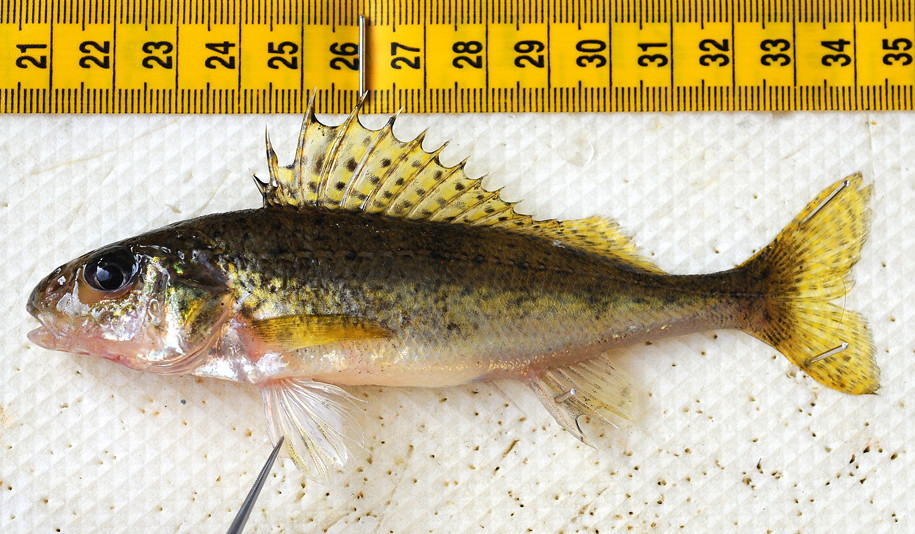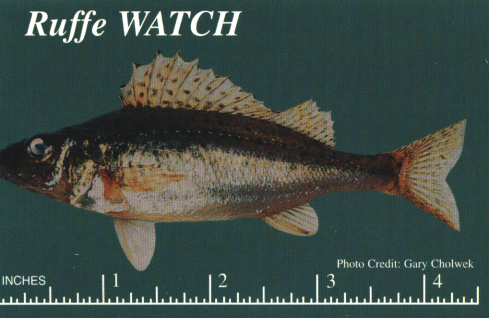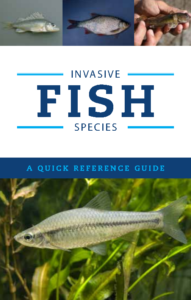Eurasian Ruffe (Gymnocephalus cernua)

Eurasian Ruffe
Order: Perciformes
Family: Percidae sp.
Common name: Ruffe
French common name: grémille eurasienne
Synonyms and Other Names: Eurasian Ruffe, blacktail, pope, redfin darter, river ruffe, Acerina cernua, Gymnocephalus cernuus
Did you know? The ruffe has an exceptional ability to detect water vibrations through organs called neuromasts which aid in finding food and avoiding predators. These neuromasts become even more sensitive and advanced as ruffe mature whereas the neuromasts of its relative, the Perch, become weaker as they mature.
Introduction
The Eurasian Ruffe (Gymnocephalus cernua) is a small freshwater fish native to Europe and Asia, known for its resilience and adaptability. Originally found in rivers, lakes, and brackish coastal waters across Eurasia, the ruffe has garnered attention as an invasive species in North America, where it poses significant ecological challenges. Their introduction into North America, primarily through ballast water from ships, has led to established populations in the Great Lakes and surrounding watersheds. As a generalist species, ruffe can adapt to many different environmental conditions and food sources which contributes to their successful establishment in new habitats. Their rapid reproduction rate facilitates population growth and colonization of new areas. This can lead to declines in native fish populations, disrupting local ecosystems and fisheries.
General Information
Ruffe exhibit a slender, elongated body with a rounded snout and a distinct dorsal fin with spines. Their coloration varies from olive-green to brown on the upper body, fading to white or cream on the belly. Dark spots or blotches often adorn their sides.
Key ID points for how to ID ruffe in order of importance:
- Rows of dark spots between rays on dorsal fin (no other fish has spots between rays except the native freshwater sauger)
- Sharp spiny dorsal fin connects to soft ray adipose fin (the small fleshy fin found posterior to the dorsal fin and anterior of the caudal fin). When the front spiny fin is pulled forward, the adipose fin also stands up; no other native or invasive fish has the combination of #1 and #2.
- Gill cover with many sharp spines
- Pectoral fins with single sharp spine
- Anal fin with two sharp spines
- Glassy eyes (like walleye)
- Small downturned mouth
- Very slimy when handed
- Usually less than 6 inches (15.5 cm) long
- Perch-like body shape and color

Eurasian Ruffe typically grow to lengths of 7-15 centimeters (2.8-5.9 inches) and weigh between 10-50 grams (0.35-1.76 ounces). Ruffe have an average lifespan of 7 years for females and 5 years for males. They mature quickly (2-3 years) with reproductive events commencing as early as 1 year under favourable conditions such as in warm, clear waters (Volta et al 2012). Ruffe utilize diverse spawning substrates, depositing their eggs in open, unguarded areas typically about 9 feet below the water’s surface. Females are capable of producing between 13,000 to 200,000 eggs per season, contributing to their ability to rapidly increase in numbers and colonize new areas (McLean, 1997). Eggs can adhere to various surfaces such as submerged plants, rocks, logs, gravel, or even sandy or clay bottoms (Ogle, 1998). Growth rates are influenced by water conditions, population density, and food availability.
Eurasian Ruffe are highly adaptable and able to thrive in a wide range of environmental conditions including water with low or high nutrients, and a wide range of depths and temperatures. However, ruffe prefer cooler temperatures and are commonly associated with mud flats, sandy and clay bottoms. Ruffe spend the days in deeper water and come to the shallows to feed at night.
Native range:
Originally from fresh and brackish waters in portions of Northern Europe and Asia (Berg 1949; Holcik and Hensel 1974; Wheeler 1978; Page and Burr 1991), the ruffe came to North America (Lake Superior) likely via ballast water of transoceanic ships arriving from a Eurasian port in the mid-1980s (Simon and Vondruska 1991; Ruffe Task Force 1992). Within the Great Lakes, the species’ distribution might have been increased by shipping within the lakes (Pratt et al. 1992; Stepien et al. 1998).
Invasive range:
In the United States, ruffe have been found along the southern shore of Lake Superior, Lake Michigan, and Lake Huron. In Ontario, Eurasian Ruffe have been recorded in Kaministiquia River, near Thunder Bay. They are suspected to be spreading east along the northern shores of Lake Superior and have been recently confirmed just outside of Sault Ste. Marie, Ontario.
Ruffe were first found in the St. Marys River in 2017 and have been captured in Lake George annually since 2022. The recent capture near Sault Ste. Marie was further south indicating that Ruffe are continuing to move south in the St. Marys River.
For an up to date distribution map of Eurasian Ruffe in Ontario, visit www.EDDMapS.org/distribution.
Environmental impacts:
Eurasian Ruffe are aggressive competitors with native fish, consuming various small aquatic organisms including zooplankton, insect larvae and small fish. The presence of hard dorsal spines on their fins, makes them difficult for other organisms to eat so they have few natural predators. Their high reproductive rate, with females capable of spawning multiple times a season, allows rapid population growth and colonization of new areas, leading to declines in native fish populations. In particular, they negatively impact valuable native sportfish like Yellow Perch and Walleye through competition for food and habitat, and by preying heavily on their eggs (McLean 1993). Adaptability to diverse environmental conditions including fresh or brackish water with low or high nutrients, and a range of depths and temperatures, further enhances their dominance, exacerbating the decline of native species.
Social and Economic Impacts:
As mentioned under environmental impacts, Eurasian ruffe populations threaten commercial/sport fishing (McLean 1997) by outcompeting native sportfish species for food and habitat. Due to their economic value, the species of main concern are yellow perch, walleye, and whitefish (Gunderson et al. 1998). Under a moderate scenario of spread and impact, it was predicted that ruffe could generate costs more than $500 million by 2050 due to valuable fish species reductions (Leigh 1998).
The Ontario government has banned the possession and sale of live or dead Eurasian Ruffe as well as using Ruffe as bait.
- Learn how to identify Eurasian Ruffe and how to prevent accidentally spreading this invasive species.
- Don’t release any live fish into Ontario lakes or rivers. Empty your bait bucket on dry land at least 30m from shore, freeze, or salt your bait for later use.
- Always drain water out of your boat, live well, and bilge before leaving water access.
- Never use ruffe as bait.
- Return or donate unwanted aquarium fish to a pet store or local school.
- If you’ve seen Eurasian Ruffe or another invasive species in the wild, please contact the toll-free Invading Species Hotline at 1-800-563-7711, visit EDDMapS, or search for the ‘Invasive Species in Ontario’ project on or go to report a sighting.
Ruffe have several native look-alikes including Juvenile Walleye, Trout Perch, Yellow Perch.



Key differences:
Ruffe:
- Perch-like body less than 20 cm (8 in) long, with glassy eyes and a downturned mouth.
- Olive-brown coloring on the back, with pale sides.
- Lack dark vertical stripes found on native yellow perch.
- Front and back dorsal fins are joined; first fin has 11-16 stiff, sharp spines with dark spots between them, second dorsal fin has soft, flexible rays.
- Sharp spines on anal fins and gill covers.
- No scales on the head.
Yellow Perch:
- Typically larger than ruffe, with a perch-like body.
- Dark vertical stripes on a yellowish body.
- Dorsal fins are separate; first dorsal fin has sharp spines, second dorsal fin has soft rays.
- Scales cover the entire body, including the head.
Walleye:
- Larger fish with elongated body.
- Usually olive or golden in color.
- Dorsal fins are separate; first dorsal fin has sharp spines, second dorsal fin has soft rays.
- Scales cover the entire body, including the head.
Factsheets
Further Reading
References
Berg, L.S. 1949. Freshwater fishes of the U.S.S.R. and adjacent countries, 4th edition. Three volumes. Translated from Russian, 1962-1965, for the Smithsonian Institution and the National Science Foundation, by Israel Program for Scientific Translations, Jerusalem, Israel. Volume 1:504 pp.; volume 2:496 pp.; volume 3:510 pp.
Gunderson, Jeffrey L., Michael R. Klepinger, Charles R. Bronte, and J E. Marsden. “Overview of the International Symposium on Eurasian Ruffe (Gymnocephalus cernuus) Biology, Impacts, and Control.” Journal of Great Lakes Research 24.2 (1998): 165-69. ScienceDirect. Web. 16 May 2014.
Holcik, J., and K. Hensel. 1974. A new species of Gymnocephalus (Pisces: Percidae) from the Danube, with remarks on the genus. Copeia 2: 471-486.
Leigh, P. 1998. Benefits and costs of the ruffe control program for the Great Lakes fishery. Journal of Great Lakes Research 24(2):351-360.
McLean, M. 1993. Ruffe (Gymnocephalus cernuus) fact sheet. Minnesota Sea Grant Program, Great Lakes Sea Grant Network, Duluth, MN.
McLean, M. 1997. Ruffe: A New Threat to Our Fisheries. Minnesota Sea Grant Program as a Joint Project of the Great Lakes Sea Grant Network, 1993, 1994, 1997 (X07).
Ogle, Derek H. “A Synopsis of the Biology and Life History of Ruffe.” Journal of Great Lakes
Research 24.2 (1998): 170-85. Print.
Page, L.M., and B.M. Burr. 1991. A Field Guide to Freshwater Fishes of North America north of Mexico. The Peterson Guide Series 42: 432 pp.
Pratt, D.M., W.H. Blust, and J.H. Selgeby. 1992. Ruffe, Gymnocephalus cernuus: newly introduced in North America. Canadian Journal of Fisheries and Aquatic Sciences 49:1616-16.
Ruffe Task Force. 1992. Ruffe in the Great Lakes: a threat to North American fisheries. Great Lakes Fishery Commission, Ann Arbor, MI.
Simon, T.P., and J.T. Vondruska. 1991. Larval identification of the ruffe, Gymnocephalus cernuus (Linnaeus) (Percidae: Percini), in the St. Louis River Estuary, Lake Superior drainage basin, Minnesota. Canadian Journal of Zoology 69: 436-441.
Stepien, C.A., A.K. Dillon, and M.D. Chandler. 1998. Genetic identity, phylogeography, and systematics of ruffe Gymnocephalus in the North American Great Lakes and Eurasia. Journal of Great Lakes Research 24 (2): 361-378.
Volta, Pietro, Erik Jeppesen, Barbara Campi, Paolo Sala, and Matthias Emmrich. “The
population biology and life history traits of Eurasian ruffe (Gymnocephalus cernua) introduced
into eutrophic and oligotrophic lakes in Northern Italy.” Journal of Limnology 72.2 (2012): 280- 90. Print.
Wheeler, A. 1978. Key to the fishes of northern Europe. Frederick Warne Ltd., London, England.


